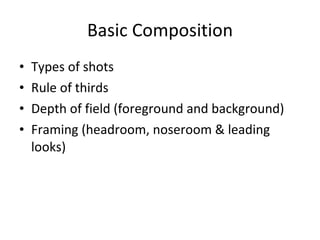Composition
- 1. Basic Composition Types of shots Rule of thirds Depth of field (foreground and background) Framing (headroom, noseroom & leading looks)
- 2. Types of shots Establishing Shot or extreme long shot Long shot Medium shot Medium close up Close up Extreme closeup
- 4. p. 2
- 5. p. 3
- 6. Different types of shots
- 7. XLS
- 8. LS
- 9. MS
- 10. MCU
- 11. CU
- 12. ECU
- 13. Rule of thirds is symmetry always good?
- 14. Rule of Thirds
- 15. p. 2
- 16. p. 3
- 17. Achieving visual balance Neither too heavy or too off-center Evaluate weight of colors and tones (dark is heavier than light) shape of objects (large objects appear heavier than small) Placement of objects (objects toward edge appear heavier than objects placed at center)
- 18. Depth of field Foreground and background
- 19. F and B
- 20. p. 2
- 21. p. 3
- 22. p. 4
- 23. p. 5
- 24. Controlling depth of field the area of the image that is acceptably sharp
- 25. Shot framing For interviews and portraits
- 26. Head Room
- 27. p. 2
- 28. p. 3
- 29. p. 4
- 30. HR rule of thirds
- 31. p. 2
- 32. p. 3
- 33. NoseRoom
- 34. p.1
- 35. p.2
- 36. p. 3
- 37. p. 4
- 38. Leading Lines
- 39. Creative Project #3: Photography Take a series of digital photographs (6 images) to explore emotional content in composition. Photos should be featured in a PowerPoint projectŌĆō6 slides total. Completed individually or in groups of 2. (PP should be inserted into a blog post). Analyze your compositions, specifically how depth of field, rule of thirds, camera distance, subject positioning, setting, lighting, color, lines and symbolism help convey an emotion, provide commentary, tell a story, and provide visual interest. Include analysis (1-2 paragraphs) in blog post to (not WebCT). One per group or individual. Due: Thursday 3/25
Editor's Notes
- Light quality, texture, focus, angle, color
- Light quality, texture, focus, angle, color
- Differential focus or selective focus







































